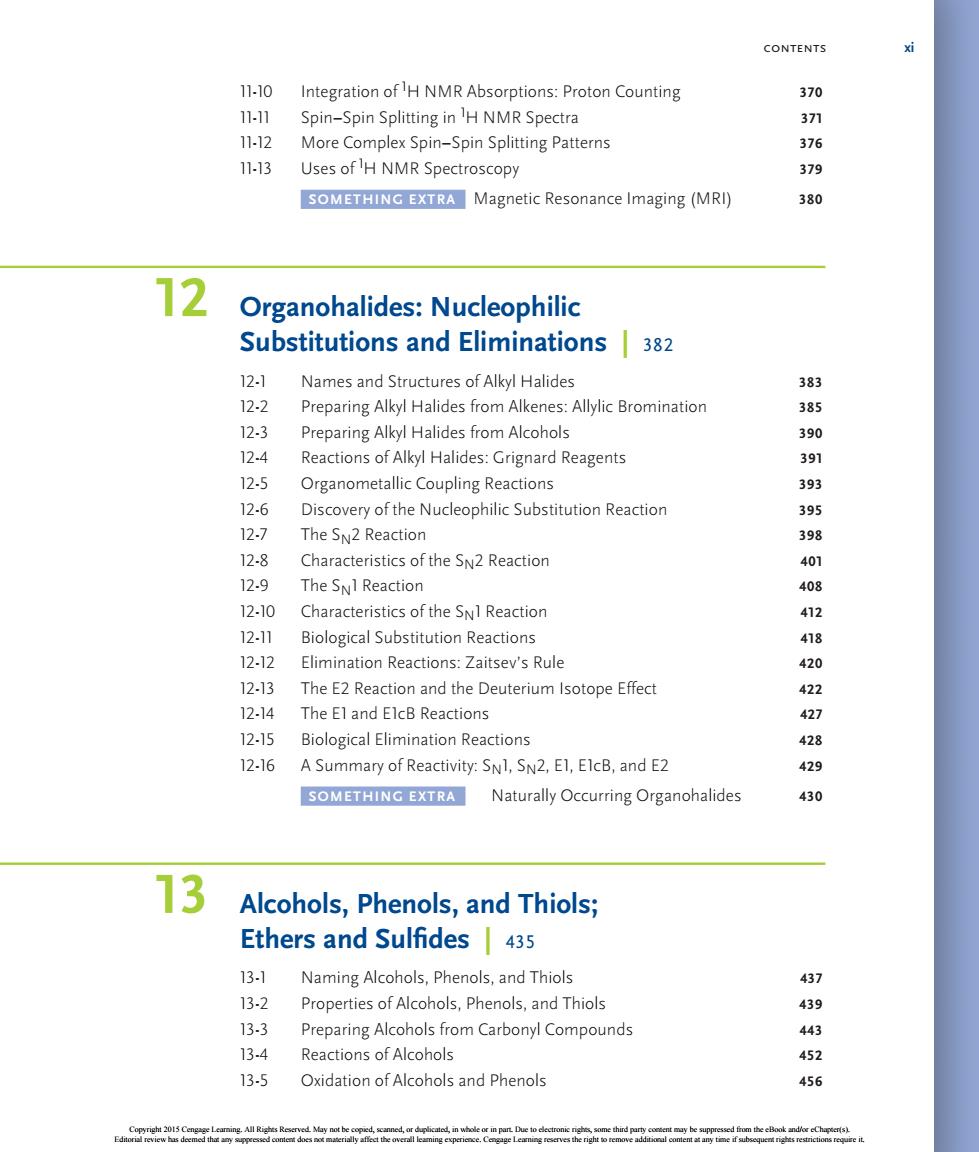正在加载图片...

CONTENTS 11-10 Integration of H NMR Absorptions:Proton Counting 370 11-1 Spin-Spin Splitting in H NMR Spectra 112 More Complex Spin-Spin Splitting Patterns 1-13 Uses of H NMR Spectroscopy 3 SOMETHING EXTRA Magnetic Resonance Imaging (MRI) 380 Organohalides:Nucleophilic Substitutions and Eliminations 382 121 Names and Structures of Alkyl Halides 383 12-2 Preparing Alkyl Halides from Alkenes:Allylic Bromination 385 12-3 Preparing Alkyl Halides from Alcohols 390 12-4 Reactions of Alkyl Halides:Grignard Reagents 391 12-5 Organometallic Coupling Reactions 393 12-6 Discovery of the Nucleophilic Substitution Reaction 395 12-7 The SN2 Reaction 3 12-8 Characteristics of the SN2 Reactior 401 12.9 The sNl Reaction 408 12-10 Characteristics of the SN1 Reaction 412 12-11 Biological Substitution Reactions 12-12 Elimination Reactions:Zaitsev's Rule 420 12-13 The E2 Reaction and the Deuterium Isotope Effect 422 12.14 The El and ElcB Reactions 12-15 Biological Elimination Reactions 428 12-16 A Summary of Reactivity:SN1,SN2,E1,EIcB,and E2 429 SoMETHING EXTRA Naturally Occurring Organohalides 430 3 Alcohols,Phenols,and Thiols; Ethers and Sulfides 435 131 Naming Alcohols,Phenols,and Thiols 13-2 Properties of Alcohols,Phenols,and Thiols 4 13-3 Preparing Alcohols from Carbonyl Compounds 43 13.4 Reactions of alcohols 4 13-5 Oxidation of Alcohols and Phenols 456Contents xi 11-10 integration of 1 h nMR absorptions: proton counting 370 11-11 spin–spin splitting in 1 h nMR spectra 371 11-12 More complex spin–spin splitting patterns 376 11-13 Uses of 1 h nMR spectroscopy 379 soMetHinG eXtra Magnetic Resonance imaging (MRi) 380 12 organohalides: nucleophilic substitutions and eliminations | 382 12-1 names and structures of alkyl halides 383 12-2 preparing alkyl halides from alkenes: allylic Bromination 385 12-3 preparing alkyl halides from alcohols 390 12-4 Reactions of alkyl halides: grignard Reagents 391 12-5 organometallic coupling Reactions 393 12-6 Discovery of the nucleophilic substitution Reaction 395 12-7 the sn2 Reaction 398 12-8 characteristics of the sn2 Reaction 401 12-9 the sn1 Reaction 408 12-10 characteristics of the sn1 Reaction 412 12-11 Biological substitution Reactions 418 12-12 Elimination Reactions: Zaitsev’s Rule 420 12-13 the E2 Reaction and the Deuterium isotope Effect 422 12-14 the E1 and E1cB Reactions 427 12-15 Biological Elimination Reactions 428 12-16 a summary of Reactivity: sn1, sn2, E1, E1cB, and E2 429 soMetHinG eXtra naturally occurring organohalides 430 13 alcohols, Phenols, and thiols; ethers and sulfides | 435 13-1 naming alcohols, phenols, and thiols 437 13-2 properties of alcohols, phenols, and thiols 439 13-3 preparing alcohols from carbonyl compounds 443 13-4 Reactions of alcohols 452 13-5 oxidation of alcohols and phenols 456 42912_00_FM_i-xxiv.indd 11 1/16/14 3:00 PM Copyright 2015 Cengage Learning. All Rights Reserved. May not be copied, scanned, or duplicated, in whole or in part. Due to electronic rights, some third party content may be suppressed from the eBook and/or eChapter(s). Editorial review has deemed that any suppressed content does not materially affect the overall learning experience. Cengage Learning reserves the right to remove additional content at any time if subsequent rights restrictions require it